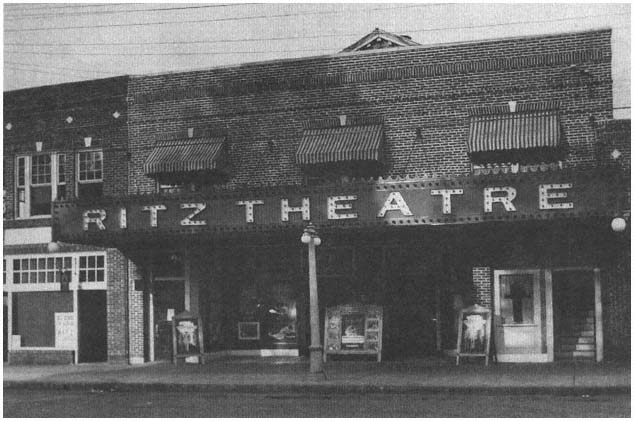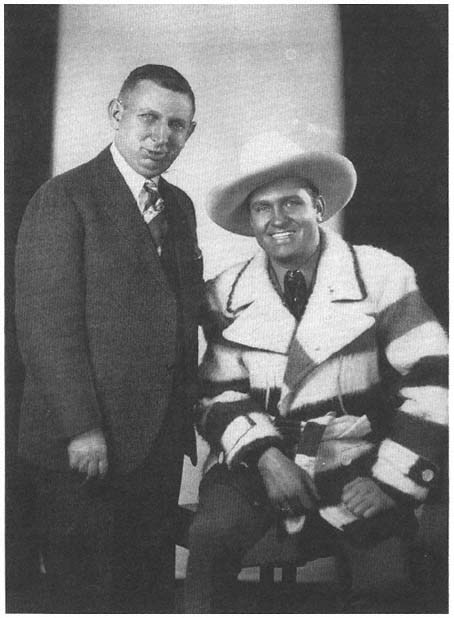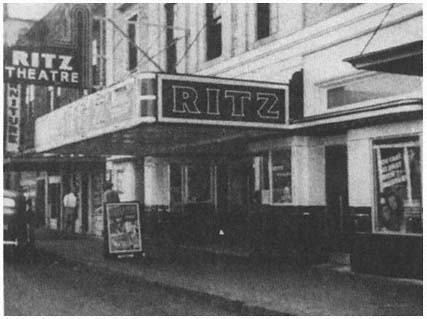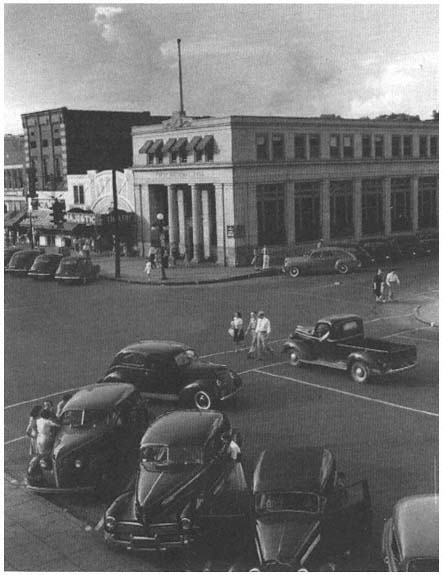1—
Fifty Years of Show Business
Formal Opening Ritz On Monday, April 30
After five months of work the Ritz theatre, Athens' latest amusement place, is now ready for the formal opening which will take place at 7:00 o'clock, Monday evening, April 30th [1928], the picture for that occasion being Mary Pickford's latest screen production "My Best Girl," followed by a comedy, "Fair and Muddy.
"Prior to the picture showing the following program will be given:
Master of ceremonies—W. E. Willis.
Music by Gene Carter's orchestra.
Welcome from the city of Athens [Alabama] to Muscle Shoals Theatres, Inc.—Mayor C. W. Sarver.
Orchestra.
Welcome on behalf of the businessmen of Athens—C. D. Beisley, president Athens Chamber of Commerce.
Orchestra.
Response to addresses of welcome by Mayor W. S. Eastep of Florence.
Solo—Mrs. Frank G. Westmoreland, with Mrs. R. H. Richardson, Jr., as accompanist.
Delivery of the building to the lessees—R. H. Walker.
Acceptance of same—Senator W. H. Mitchell of Florence, director of the Muscle Shoals Theatres, Inc.
Orchestra.
Photoplays—"The Czarina's Secret"; comedy "Fair and Muddy."
Mary Pickford in her latest photoplay, "My Best Girl."
Unusual interest has been manifested in the opening of the Ritz and the indi-
cations are that the theatre will be filled to capacity on the occasion of the formal opening. Among the guests who will be present from a distance may be mentioned, Tony and Harry Sudekum, C. H. Dean and others from Nashville, T. M. Rogers, O. C. Hackworth, Senator W. H. Mitchell and Mayor Eastep of Florence, while a number from Decatur have signified their intention of attending.
The opening of the Ritz on Monday evening marks the completion of five months of hard labor in constructing an up-to-date theatre and movie house that would be creditable to a town much larger than Athens. The building occupies the site of the old M. E. church, one of the historic buildings of North Alabama, which was erected in 1836. The walls and roof of the old building were retained in the new building and the attractive cove ceiling of the old church adds to the beauty of the new place. The theatre is 105 feet long and 44 feet in width with double lobbies, the manager's office and box office being on south sides of the lobbies and the ladies' dressing room and the entrances to the offices on the second floor being on the north side. The main auditorium is 72 feet in length with 462 opera chairs unusually comfortable with cushion seats. It contains a regulation orchestra pit, while there is ample space for standing room in the rear of the balustrade. The section of the balcony reserved for whites is reached by a stairway just inside the auditorium. Under this stairway is the gentlemen's rest room.
The balcony contains 150 veneered seats, 66 of which are reserved for colored persons. Ten additional seats may be added in an emergency. These seats are also quite comfortable and of the latest type. In the balcony is located the operator's booth, containing two new type 6B Powers machines. The booth has a cement floor and is lined inside and out with sheetrock, making this part as nearly fireproof as humanly possible. The booth is entered through an automatic fireclad door. Entrance to the colored section of the balcony is reached by a stairway on the south side of the building next to Copeland's store.
The stage extends clear across the east of the building with 15×24 ft. opening. Under the stage is the basement which contains the dressing rooms and the furnace for heating the building. A 6-ft. Typhoon fan is placed over each wing, drawing fresh air in from the outside and distributing it into the house through the grilles, making the place cool and comfortable in the warmest weather. Each fan is run by a three-horse horse [sic ] electric motor.
The theatre renders it possible to give large plays and up-to-date vaudeville shows by reason of the stage arrangements, including ample room for scenery. Regulation footlights are also provided.
The front of the building is adorned with a marquise [sic ] 10 feet wide and 44 feet in length. Around the marquise has been erected a sign 42 inches high with over 500 electric lights in it. On each end are the words in channel lights "Ritz Theatre," while the same words in larger channel lights adorn the front of the sign.
Work of tearing down the rear wall and old organ loft and the inside of the old church was started Nov. 22, 1927, the day on which R. H. Walker signed the contract with the J. W. Chambers Lumber Co., for the construction of the Ritz. Work was somewhat retarded by bad weather, but once the foundation for the addition to the old building was completed, rapid progress was made.

Ritz Theater, Athens, Alabama
The capable foreman on the job was Raymond H. Patterson, a native Limestone boy, whose untiring efforts to make the building just what the architects, Marr & Holman of Nashville, had planned it were aided in every possible way by every man on the job. The work was done harmoniously and efficiently and illustrated the effectiveness of genuine team work. The building is a strong testimonial to the contractors and to the workmen, as well as speaking volumes for the well known architects.
This is the lead cover story of the Limestone Democrat, Athens, Alabama, April 26, 1928—a newspaper incidentally owned and edited by R. H. Walker, builder and owner of the Ritz. The remainder of the front page is devoted to the same subject, including a half-page ad for the Ritz opening that features a list of the first programs—King Vidor's The Crowd on Tuesday, May 1, only; Sally O'Neil and Molly O'Day in Lovelorn on May 2; Now We're in The Air , The Love of Sunya , and Jesse James all coming; prices, 10¢ and 25¢—and a message of greeting from Louis Rosenbaum, general manager of Muscle Shoals Theatres, Inc.
There's a photograph and profile of my grandfather on page six, where he's identified as co-purchaser of North Alabama Enterprises with Tony and Harry Sudekum of Crescent Amusement Company. At this time Louis Rosenbaum had been in the movie theater business for fourteen years, having leased a theater in Douglas, Wyoming, whose first bill presented Theda Bara in A Fool There Was , and operated another one in North Little Rock, Arkansas, before coming to Florence, Alabama, with his wife Anna and nine-year-old son Stanley in 1919, still in his early thirties.
By 1928, in partnership with the Sudekum brothers, he owned the Princess Theatre, built in Florence the same year he arrived, an $85,000 brick and steel structure with a Spanish façade, glass chandelier, cork linoleum floor ("to hush every footfall"), two boxes, fourteen exits, and an original seating capacity of twelve hundred. Through leases he also ran the Majestic in Florence, the Palace in Sheffield, the Strand in Tuscumbia, and the Ritz in Athens, and he was preparing to build another Ritz in Sheffield. Business, needless to say, was booming.
The picture of Louis Rosenbaum with Gene Autry was taken in 1939, when Autry came to Florence to appear at the Princess, stayed at Louis's house, and the two men struck up a brief, enigmatic friendship. By that time Stanley, my father, was back from Harvard and the University of Denver—unable to land a teaching job or to sell his short stories—and was working as a manager at the Sheffield Ritz, shown here in the same year. (It looks like a Saturday program: The Magnificent Fraud and You Can't Get Away With Murder , with a Lone Ranger serial.) The previous year he had gone to New York to write a book and married Mildred Bookholtz instead; now the two were living at Lou and Anna's house on Riverview Drive, preparing to live in a house across the street that Frank Lloyd Wright had designed for

Louis Rosenbaum and Gene Autry, 1939

Ritz Theatre, Sheffield, Alabama, 1939
them and which was being built on an acre of land where Annie Oakley had once performed.
I don't know what was playing at the Majestic on the Saturday afternoon in 1942 when Arthur Rothstein snapped a picture of the middle of downtown Florence on Court Street, as part of a federal project; that was the year before I was born. But a month before my thirteenth birthday, the day before I saw Footsteps In The Fog at the Shoals, I duly noted in my diary that Bo—the name that I and my brothers David (14), Alvin (11), and Michael (8) gave to Louis, reportedly derived from a Dumbo doll owned by David in his infancy—had bought out the Sudekums. What I didn't realize at the time was that this parting of the ways was a legal requirement, the business having been hit by an antitrust suit. (When someone began building a competitive movie theater in Athens, apparently with the intention of selling out to the Sudekums and Rosenbaums, their company retaliated by building a third house, the Plaza. This happened around the time of the Supreme Court's divestiture order in 1948, and the government sued Muscle Shoals Theatres for this maneuver as a test case. Eventually the suit led to the dissolution of the partnership in 1956.)
In 1960 Rosenbaum Theatres—still operating in the Tri-Cities and Athens, but with a constellation of active movie houses that had shrunk from nine to

Majestic Theatre, Florence, Alabama, 1942
five—was sold to the Martin theater chain, the largest in the South. My grandfather Bo retired, and my father started a new career teaching English literature at Florence State University, known today as University of North Alabama. Less than ten years after that, in New York, I became a film critic.
Two weeks ago, on my thirty-fifth birthday, February 27, 1978, the following item appeared on the eighteenth and final page of the Florence Times—Tri-Cities Daily, devoted to a "Weekly Business and Industrial Review," roughly half a century after the opening of the Ritz in Athens.
New Theatre To Open In March
The new triple-screen Hickory Hills Cinemas will open to the public March 10 with three movies never before seen in the Shoals, the president of the firm which is operating the theatres said Saturday.
A. Foster McKissack said the three-screen theatre on Florence Blvd. will have a total seating capacity of 800 with the ability to show either separate movies, or show the same film in two of the cinemas.
McKissack said this was possible through the use of a centralized projection room.
McKissack and his southeast film booking manager, Jack Jordan, said the emphasis in the triple cinemas had been placed on comfort. Jordan said the aisles, distance between seats and the seats themselves were wide enough to allow the customer to be undisturbed by others.
Jordan said the movie houses and films were enjoying a renaissance with records being set in attendance last year and an apparently healthy start to this year.
"Many people raised on television have discovered movies," Jordan said, "and many films such as 'Saturday Night Fever' have been unexpected hits." This film has been pushed to the top by "word-of-mouth" advertising, Jordan said.
Jordan said the theatres will also have a telephone number which can be called 24 hours per day which will give the current attractions, the times of showing and the ratings. The number is 766-7700.
There will be special admission price for children under 14 years of age, Jordan said, and he predicted that the Shoals operation would be getting films "on or near the national release date."
The opening films scheduled are "Semi-Tough," starring Burt Reynolds, Kris Kristopherson [sic ] and Jill Claybrook [sic ]; "Other Side of the Mountain, Part II," with Jill Claybrook [sic ]; and "Jason and the Argonauts."